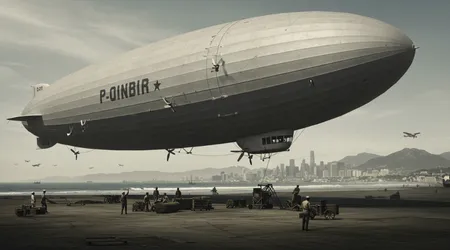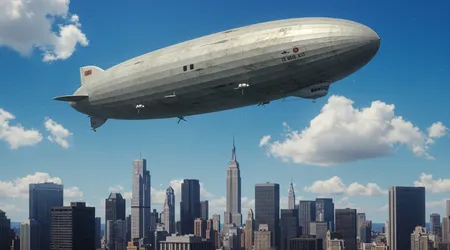Why We Stopped Using Zeppelins for Travel

The phrase stopped using Zeppelins for travel echoes a bygone era when massive airships ruled the skies, promising luxurious, leisurely journeys across continents.
Anúncios
These floating giants, often romanticized as “hotels in the sky,” captivated imaginations with their grandeur and ambition.
Yet, their decline was swift, driven by a mix of tragedy, technological shifts, and economic realities.
This article dives into the multifaceted reasons behind their fall, exploring safety concerns, competition from airplanes, economic challenges, and the lingering allure of airships in modern times.
With a blend of historical insight and contemporary analysis, we uncover why Zeppelins faded and whether they might ever return.
Anúncios
Zeppelins, named after German inventor Count Ferdinand von Zeppelin, were engineering marvels of the early 20th century.
They offered unmatched comfort, with plush cabins and dining rooms, ferrying passengers across oceans in style. But their story is one of brilliance overshadowed by practical limitations. Why did humanity abandon these skyward dreams?
Let’s unravel the factors that grounded them, from catastrophic accidents to the rise of faster, more reliable alternatives, and consider what their legacy means in 2025.
The Hindenburg Disaster: A Turning Point
The Hindenburg’s fiery demise in 1937 remains the most infamous airship disaster, searing the dangers of Zeppelins into public memory.
On May 6, the German airship, filled with flammable hydrogen, erupted in flames while attempting to land in Lakehurst, New Jersey.
Of the 97 passengers and crew, 35 perished, alongside one ground worker. The tragedy, captured on film, shattered confidence in airship travel overnight.
Media coverage amplified the horror, with newsreels broadcasting the inferno worldwide. Public perception shifted dramatically; Zeppelins, once symbols of progress, became synonymous with peril.
++ The Great Fireproof Cities Plan That Never Happened
The incident wasn’t isolated earlier crashes, like the British R101 in 1930, had already raised concerns. Yet, the Hindenburg’s spectacle was unmatched, cementing a narrative of risk that lingered.
This fear wasn’t entirely irrational. Hydrogen, used due to helium’s scarcity and U.S. export restrictions, was highly flammable.
Modern airships, like LTA Research’s Pathfinder 1, use helium, but in 1937, safer alternatives were limited. The disaster forced a reckoning, making safety a non-negotiable priority for air travel.

The Rise of Airplanes: Speed Over Serenity
As Zeppelins faltered, airplanes soared. By the late 1930s, aircraft like the Douglas DC-3 offered faster, more reliable travel.
While Zeppelins took days to cross the Atlantic, planes did it in hours. This speed gap was a game-changer, especially for business travelers prioritizing efficiency over luxury.
Airplanes also proved more versatile. Zeppelins required massive mooring masts and ground crews, limiting their routes.
Planes, needing only runways, could serve more destinations. By 1940, commercial aviation was booming, with airlines expanding rapidly. Zeppelins, once cutting-edge, couldn’t keep pace.
Also read: Tesla’s Earthquake Machine: Real Invention or Urban Legend?
Consider a 1930s transatlantic journey: a Zeppelin like the Graf Zeppelin took about 60 hours to cross from Germany to the U.S., while early planes cut that time significantly.
Passengers valued speed, and airlines capitalized on it, rendering airships obsolete for mainstream travel.
Economic Realities: The Cost of Floating Giants
Operating Zeppelins was exorbitantly expensive. Their massive size demanded vast amounts of helium or hydrogen, extensive crews, and specialized infrastructure.
For example, the Hindenburg required 200 ground crew members for mooring. These costs made tickets pricey, limiting the market to the wealthy.
In contrast, airplanes offered economies of scale. As aviation technology improved, planes carried more passengers at lower costs.
By the 1950s, airfares dropped, democratizing air travel. Zeppelins, with their high operational overhead, couldn’t compete in this new economic landscape.
A 2025 report by Research and Markets notes that modern airship prototypes, like those from Hybrid Air Vehicles, aim for 90% lower emissions than jets, yet high production costs remain a barrier.
Read more: Forgotten Sound Mirrors: Britain’s Early Warning System Before Radar
This economic hurdle echoes the past, where profitability grounded Zeppelins as much as safety concerns did.
Helium, though safer than hydrogen, posed its own challenges. Its scarcity and cost, even today, complicate airship economics.
In 1937, helium’s price was a significant factor; in 2025, volatile pricing still hinders scalability, as noted by historian John J. Geoghegan. These persistent issues highlight why Zeppelins struggled to remain viable.
Wartime Shifts: Zeppelins as Military Relics
World War I saw Zeppelins repurposed as bombers, but their vulnerability to explosive bullets ended their military dominance.
By World War II, their role diminished further. Airplanes, faster and harder to target, became the backbone of aerial warfare, sidelining airships.
Post-war, the focus shifted to rebuilding commercial aviation. Zeppelins, associated with German militarism and pre-war luxury, lost favor.
The U.S., a key aviation hub, prioritized planes, with companies like Boeing leading the charge. Airships became relics of a fading era.
Military interest in airships persists in niche roles, like surveillance, but their wartime legacy tainted their commercial appeal. The public, wary of their history, embraced the sleek, modern airplane instead, sealing Zeppelins’ fate.
Cultural Shifts: The Allure of Progress
Zeppelins embodied a romantic vision of travel slow, majestic, almost dreamlike. But post-war culture craved speed and modernity.
Airplanes, with their sleek designs and futuristic promise, captured the zeitgeist. Think of the Concorde’s allure in later decades: speed was sexy, airships were passé.
Popular media reinforced this shift. Films and advertisements glorified jet travel, while Zeppelins appeared in historical dramas, not contemporary aspirations.
The public’s taste for innovation outpaced the airship’s nostalgic charm, pushing them further into obscurity.
Imagine a 1950s couple planning a honeymoon: a sleek Pan Am flight to Paris felt thrillingly modern, while a Zeppelin voyage seemed like a step backward.
This cultural pivot, subtle but powerful, helped cement why we stopped using Zeppelins for travel.
Modern Revival Attempts: A Niche Comeback?

In 2025, airships are stirring again, driven by eco-conscious innovation. LTA Research’s Pathfinder 1, backed by Sergey Brin, completed its first untethered flight in 2024, using helium and electric motors.
These modern airships target cargo and tourism, not mass transit, aiming for sustainability.
Yet, challenges remain. High costs, limited infrastructure, and public skepticism hinder widespread adoption.
Hybrid Air Vehicles’ Airlander 10 promises lower emissions, but scaling production is daunting. The dream of airship travel persists, but practicality lags behind.
Could Zeppelins reclaim the skies? Unlike airplanes, which dominate with speed, airships offer leisurely, low-carbon travel.
Their niche think luxury cruises or remote cargo delivery suggests a future, but not a revolution. The past teaches us that ambition alone isn’t enough.
The Legacy of Zeppelins: Lessons in Innovation
The story of why we stopped using Zeppelins for travel is a cautionary tale about innovation’s limits. Safety, economics, and cultural shifts grounded these giants, despite their grandeur.
Their legacy reminds us that even the most dazzling inventions can fade when practicality falters.
Reflect on the typewriter: once revolutionary, it was outpaced by computers, much like Zeppelins by planes.
This analogy underscores a truth technology must evolve with human needs. Zeppelins, though romantic, couldn’t match the world’s demand for speed and affordability.
Today, as we chase sustainable travel, airships offer lessons. Their low-carbon potential is enticing, but without addressing cost and scale, they risk remaining a curiosity.
The Zeppelin’s story urges us to balance vision with pragmatism in our quest for progress.
Data Snapshot: Zeppelin vs. Airplane Travel in the 1930s
| Metric | Zeppelin (Hindenburg) | Airplane (DC-3) |
|---|---|---|
| Transatlantic Travel Time | ~60 hours | ~20 hours |
| Passenger Capacity | 50-70 | 21-32 |
| Ticket Cost (1930s USD) | ~$400 | ~$100 |
| Infrastructure Needs | Mooring masts, large crews | Runways, smaller crews |
Source: Historical records from the Smithsonian National Air and Space Museum
This table highlights the stark contrast in efficiency and cost, key reasons we stopped using Zeppelins for travel.
Conclusion: A Skyward Dream Grounded
The decline of Zeppelins wasn’t just about one fiery crash or a single competitor’s rise it was a convergence of safety fears, economic pressures, and a world racing toward speed.
The Hindenburg’s flames burned away public trust, while airplanes promised efficiency that airships couldn’t match.
Cultural shifts and wartime legacies further buried the Zeppelin’s dream, leaving it a footnote in aviation history.
Yet, in 2025, as we grapple with climate goals, their low-carbon potential sparks curiosity. Could airships rise again, or are they forever tethered to nostalgia?
The answer lies in balancing innovation with the hard lessons of the past. For now, the skies belong to jets, but the Zeppelin’s story reminds us to dream boldly while keeping our feet on the ground.
Frequently Asked Questions
Why did the Hindenburg disaster have such a lasting impact?
The Hindenburg’s 1937 crash, captured on film, turned public opinion against airships, associating them with danger due to flammable hydrogen use.
Are Zeppelins completely obsolete in 2025?
No, modern airships like Pathfinder 1 are being tested for cargo and tourism, but high costs and limited infrastructure hinder widespread use.
Could Zeppelins be a sustainable travel option today?
Potentially, as they emit up to 90% less than jets, but economic and logistical barriers make mass adoption unlikely in the near future.
What was a key economic factor in Zeppelins’ decline?
High operational costs, including helium and large crews, made Zeppelins less competitive than airplanes, which offered lower fares and scalability.
